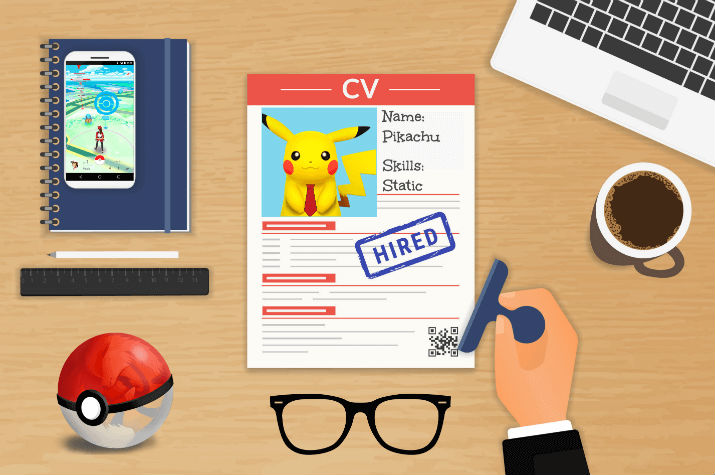Do you struggle to tell a Jigglypuff from a Bulbasaur? Does augmented reality still sound like something from a sci-fi movie? Find out why Pokemon Go is taking the world by storm, and learn what it will mean for recruitment agencies in the very near future…
Although augmented reality (AR) has been around for a while, well, it’s kind of a thing now. It’s got legs. It’s also got arms and a head, and its name is Pokemon Go. This now goes way beyond kids playing video games, so bear with me…
What is Pokemon Go?
Pokemon Go is a free-to-play, cross-platform mobile game developed by Niantic – and it sent Nintendo’s share prices through the roof almost as soon as it (quite literally) hit the streets. Even before its official release, players were finding ways to download Pokemon Go in the UK, and now that it’s finally been released here, it’s popularity has quickly gone stratospheric.
You’re anxious to close this deal, but you just can’t make that final decision – is the candidate right for the role or not?
The game itself involves hunting down and defeating a number of collectible cartoon creatures (the eponymous Pokemon) – but things go much deeper than that. Thanks to the wonders of AR, and the built-in camera on your smartphone, those creatures can appear in a multitude of real-life places. They could pop up in your living room, office, the park, supermarket, you get the gist. The game actually uses what’s technically known as ‘mixed reality’, but we’re using the term ‘augmented reality’ here to avoid confusion.
Reports are already coming in that the game has been working wonders for getting depression sufferers out of the house, and hunting for AR pokemon is now so popular that the US Holocaust Memorial Museum has had to remind gamers to respect its dignity by not playing within its grounds. Clearly pokemon Go is a big deal, but what does all of this mean for recruitment?
Professional uses for augmented reality
As you may have heard, AR isn’t just for chasing pokemon around your local neighbourhood. In fact it has a variety of other, perhaps more obviously useful applications…
Consider, for instance, a Surgeon, who can receive real-time information on patients they are operating on, thanks to a medical augmented reality system. AR systems have already been developed which allow Pilots to land more easily during periods of poor visibility. Clearly, such technology could save many lives, and it is now well into the realm of science fact rather than science fiction.
Why do I care? What does augmented reality mean for recruitment?
So, while you might not spend your days scrubbed-up in theatre, or landing planes during storms, I’m here to tell you that AR has its uses in the Recruitment Industry. Those who stay ahead of the curve stand to reap the rewards in years to come – especially by using AR to recruit Millennials, Generation Z, and whoever might come after them.
Future tech of recruitment: how to tell if a candidate is lying
Picture the scene; you’re sat in Interview Room C at work with a potential candidate for a lucrative job in the Marketing Sector. You want to make this placement. You need to make this placement. It’ll put your team nicely over that all-important incentive threshold for the month, as well as netting you a nice commission just in time to get a good deal on that new motor you’ve been after…
But something about this candidate just seems different. It could be good, or it could be bad. You can’t put your finger on which one it is, but you wish you could. They could either be perfect for the role or a complete disaster of false confidence, exaggerated experience, and counterfeit qualifications. You’re anxious to close this deal, but you just can’t make that final decision – are they right for the role or not?
Now imagine that you’re wearing a set of AR contact lenses. We’ve already shown that the tech is on its way, after all…
“People who are crazy enough to think they can change the world are the ones who do.” – Steve Jobs
As you look the candidate in the eye and ask a question about a past employer, your lenses flag something. The subject’s pupils have dilated by over 1.2mm, yet the ambient lighting level in the interview room has remained constant. This correlates with an apparent quickening of heart rate as measured optically at the jugular, and a marginal increase in the reflectivity of the skin – suggesting that sweat production has spiked.
The odds are in. Based on current academic research, your app calculates a 66% chance that the candidate is lying. This is all but confirmed when symptoms become more severe as you continue your line of enquiry. Calculated probability of a lie rises to 80%. You finally decide to wrap the interview up when you throw in a red herring and the candidate’s pupils quickly snap back to size. They won’t be meeting your client after all – on this day or any other.
Those lenses were a wise investment after all – despite the way those ‘more experienced’ colleagues scoffed when you first wore them into the office. This isn’t from the set of a near-future video game – nor is it a scene from a William Gibson novel – it’s right now, and you just sidestepped a very bad apple.
Training candidates on-site
Take another scenario – perhaps a little more far-fetched this time, but still well within the bounds of what’s possible with current technology. In fact, probably the main boundary to this one would be legal red tape.
How frustrating is it when you find a candidate that you know would be just perfect for a role, if only they had the right training and permits. What’s more, the client needs someone to start in three days’ time, and there’s going to be no opportunity to put this candidate through a short course to get them up-to-speed before then. There’s nothing else for it – you’re going to have to put forward the ‘second best’ option. Unfortunately, that represents a pretty big drop-off in this case.
But what if there was another way? What if candidate numero uno could become receive basic certification on that particular model of forklift truck right this minute over in the training room (which measures 10ft by 8ft and doesn’t contain any pallets)?
“I know Kung fu.” – Neo (The Matrix, 1999)
What if they could re-validate their health and safety certificate for that Construction job, or become proficient with a broadsword without ever leaving the building (hey, Theme Park Entertainment Staff need training too, you know!)? It could be a bit like the scene from the Matrix that I quote above – Neo gets plugged in and they download all sorts of martial arts skills directly into his consciousness. Ok, perhaps not exactly like that, but you see what I mean…
Of course, legal requirements may have to change first (to allow things like getting a forklift permit without actually touching a forklift), but augmented reality could make all of the scenarios above possible. Once someone has the idea to do it, and the right validated training packages become available, you could conceivably download all the training a candidate would need to be ready to start a job at the drop of a hat.
Simply leave them in a room for a bit with a set of AR specs, and the system tells you whether they passed or failed – downloading any relevant certifications over an encrypted connection and printing them out at your end. Job done, and no more near misses where you end up sending the ‘B-spec’ candidate.
How realistic is augmented reality’s role in the future of recruitment and training?
The above is all well and good, but, to be fair, it does sound a long way from a mobile phone game where you chase brightly-coloured pokemon around the street, while trying to throw balls at them. So how realistic is all of this stuff?
Think back to when you were a kid. That might not be very long ago at all, or it could be a very long time ago – depending on your viewpoint. Even though I was born (fairly) recently, in 1984 (or Orwell’s year as I prefer to call it), I’m still wowed at times by some of the technological advancements that humanity has made in the meantime.
I remember being sat in my parents’ living room watching Tomorrow’s World (OK, that might age me slightly), and thinking that when we had flat-screen TVs, we would truly be living in the future. I remember CDs and DVDs coming out – and I remember the first satellite navigation system I ever owned (actually I still have it). All of these things were massive leaps forward at the time, but now most of us couldn’t imagine the world without them. Don’t even get me started on the internet.
With the increased investment in AR technology that pokemon Go will create, the technology is likely to see growth in the very near future – not least from the plethora of copycat games that will inevitably spawn from its inception. Bandwagoning aside, investment is likely to see the mainstream acceptance of the tech – and that is where business will begin to benefit.
While it might not be this week, our prediction is that there are very real ways that recruitment could benefit from AR – and that they will be here sooner rather than later. In the meantime, we’re still on the lookout for our next pokemon to catch.



